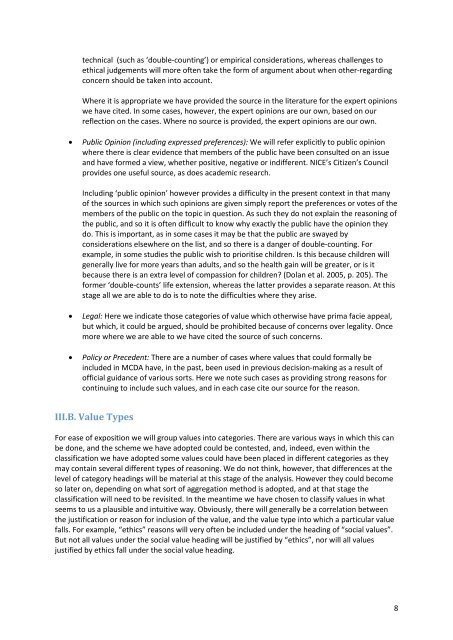What Values Should Count in Value Based Pricing for the NHS - UCL
What Values Should Count in Value Based Pricing for the NHS - UCL
What Values Should Count in Value Based Pricing for the NHS - UCL
Create successful ePaper yourself
Turn your PDF publications into a flip-book with our unique Google optimized e-Paper software.
technical (such as ‘double‐count<strong>in</strong>g’) or empirical considerations, whereas challenges to<br />
ethical judgements will more often take <strong>the</strong> <strong>for</strong>m of argument about when o<strong>the</strong>r‐regard<strong>in</strong>g<br />
concern should be taken <strong>in</strong>to account.<br />
Where it is appropriate we have provided <strong>the</strong> source <strong>in</strong> <strong>the</strong> literature <strong>for</strong> <strong>the</strong> expert op<strong>in</strong>ions<br />
we have cited. In some cases, however, <strong>the</strong> expert op<strong>in</strong>ions are our own, based on our<br />
reflection on <strong>the</strong> cases. Where no source is provided, <strong>the</strong> expert op<strong>in</strong>ions are our own.<br />
<br />
Public Op<strong>in</strong>ion (<strong>in</strong>clud<strong>in</strong>g expressed preferences): We will refer explicitly to public op<strong>in</strong>ion<br />
where <strong>the</strong>re is clear evidence that members of <strong>the</strong> public have been consulted on an issue<br />
and have <strong>for</strong>med a view, whe<strong>the</strong>r positive, negative or <strong>in</strong>different. NICE’s Citizen’s Council<br />
provides one useful source, as does academic research.<br />
Includ<strong>in</strong>g ‘public op<strong>in</strong>ion’ however provides a difficulty <strong>in</strong> <strong>the</strong> present context <strong>in</strong> that many<br />
of <strong>the</strong> sources <strong>in</strong> which such op<strong>in</strong>ions are given simply report <strong>the</strong> preferences or votes of <strong>the</strong><br />
members of <strong>the</strong> public on <strong>the</strong> topic <strong>in</strong> question. As such <strong>the</strong>y do not expla<strong>in</strong> <strong>the</strong> reason<strong>in</strong>g of<br />
<strong>the</strong> public, and so it is often difficult to know why exactly <strong>the</strong> public have <strong>the</strong> op<strong>in</strong>ion <strong>the</strong>y<br />
do. This is important, as <strong>in</strong> some cases it may be that <strong>the</strong> public are swayed by<br />
considerations elsewhere on <strong>the</strong> list, and so <strong>the</strong>re is a danger of double‐count<strong>in</strong>g. For<br />
example, <strong>in</strong> some studies <strong>the</strong> public wish to prioritise children. Is this because children will<br />
generally live <strong>for</strong> more years than adults, and so <strong>the</strong> health ga<strong>in</strong> will be greater, or is it<br />
because <strong>the</strong>re is an extra level of compassion <strong>for</strong> children? (Dolan et al. 2005, p. 205). The<br />
<strong>for</strong>mer ‘double‐counts’ life extension, whereas <strong>the</strong> latter provides a separate reason. At this<br />
stage all we are able to do is to note <strong>the</strong> difficulties where <strong>the</strong>y arise.<br />
<br />
<br />
Legal: Here we <strong>in</strong>dicate those categories of value which o<strong>the</strong>rwise have prima facie appeal,<br />
but which, it could be argued, should be prohibited because of concerns over legality. Once<br />
more where we are able to we have cited <strong>the</strong> source of such concerns.<br />
Policy or Precedent: There are a number of cases where values that could <strong>for</strong>mally be<br />
<strong>in</strong>cluded <strong>in</strong> MCDA have, <strong>in</strong> <strong>the</strong> past, been used <strong>in</strong> previous decision‐mak<strong>in</strong>g as a result of<br />
official guidance of various sorts. Here we note such cases as provid<strong>in</strong>g strong reasons <strong>for</strong><br />
cont<strong>in</strong>u<strong>in</strong>g to <strong>in</strong>clude such values, and <strong>in</strong> each case cite our source <strong>for</strong> <strong>the</strong> reason.<br />
III.B. <strong>Value</strong> Types<br />
For ease of exposition we will group values <strong>in</strong>to categories. There are various ways <strong>in</strong> which this can<br />
be done, and <strong>the</strong> scheme we have adopted could be contested, and, <strong>in</strong>deed, even with<strong>in</strong> <strong>the</strong><br />
classification we have adopted some values could have been placed <strong>in</strong> different categories as <strong>the</strong>y<br />
may conta<strong>in</strong> several different types of reason<strong>in</strong>g. We do not th<strong>in</strong>k, however, that differences at <strong>the</strong><br />
level of category head<strong>in</strong>gs will be material at this stage of <strong>the</strong> analysis. However <strong>the</strong>y could become<br />
so later on, depend<strong>in</strong>g on what sort of aggregation method is adopted, and at that stage <strong>the</strong><br />
classification will need to be revisited. In <strong>the</strong> meantime we have chosen to classify values <strong>in</strong> what<br />
seems to us a plausible and <strong>in</strong>tuitive way. Obviously, <strong>the</strong>re will generally be a correlation between<br />
<strong>the</strong> justification or reason <strong>for</strong> <strong>in</strong>clusion of <strong>the</strong> value, and <strong>the</strong> value type <strong>in</strong>to which a particular value<br />
falls. For example, “ethics” reasons will very often be <strong>in</strong>cluded under <strong>the</strong> head<strong>in</strong>g of “social values”.<br />
But not all values under <strong>the</strong> social value head<strong>in</strong>g will be justified by “ethics”, nor will all values<br />
justified by ethics fall under <strong>the</strong> social value head<strong>in</strong>g.<br />
8
















